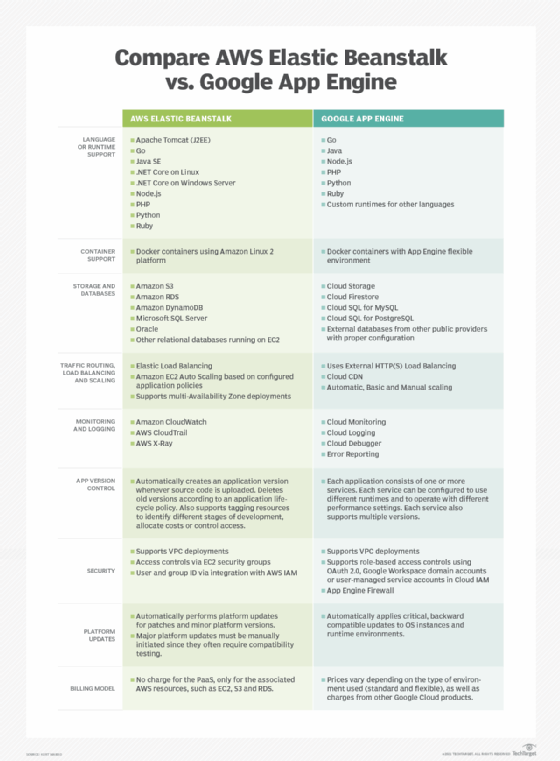PaaS showdown: AWS Elastic Beanstalk vs. Google App Engine
AWS and Google Cloud offer their own flavor of PaaS. While they share some similarities, take a closer look at their core features and use cases before you choose an offering.
With PaaS, cloud developers can free themselves from the burden of needing to provision, configure and manage infrastructure. Instead, they can focus on application code.
Organizations increasingly see the appeal in this approach, with Gartner's latest estimates indicating that PaaS amounts to a $60 billion business. The analyst firm projects 2021 global PaaS spending to jump nearly 30% over the previous year. This will account for about 42% of total IaaS-PaaS revenue.
With compiled container images support, almost any application that can be deployed on IaaS can run in a serverless PaaS framework. AWS Elastic Beanstalk and Google Cloud App Engine are two such offerings.
This AWS Elastic Beanstalk vs. Google Cloud App Engine comparison looks at key features and typical use cases.
Overview and benefits
The AWS Elastic Beanstalk platform is used to deploy applications. It is designed for web applications. Initially, Elastic Beanstalk used Apache Tomcat as the J2EE runtime environment. Google App Engine is a similar framework for web applications. It supports several web technologies along with persistent storage. It does this via a network file system and NoSQL database.
This article is part of
What is PaaS? Platform as a service definition and guide
Both products have expanded their supported languages and runtime environments, which increased the benefits of using PaaS products. Even so, they remain targeted to dynamic web applications, mobile and packaged API back ends.
PaaS offering benefits
For developers and IT operations teams, the primary benefit of using a cloud service like Elastic Beanstalk or App Engine is the elimination of overhead for infrastructure configuration, deployment, scaling, security or management. Other advantages include:
- automatic load balancing, traffic splitting and routing;
- traffic splitting to simplify hosting many versions of an application;
- shifting users from canary to beta to production versions as needed;
- integration with cloud logging, monitoring and other diagnostic tools;
- automatic application version control;
- automatic updates of the runtime environments; and
- pre-certified compliance with many regulatory standards.
Comparing features
Elastic Beanstalk and App Engine have so much in common that feature or implementation differences will rarely be a deciding factor in choosing which to use. Instead, developers will be influenced by other factors such as their existing cloud relationship and expertise, as well as cost.
The following table compares the two products across a range of key features.

Use cases
Both AWS Elastic Beanstalk and Google App Engine are optimized for dynamic web applications. These types of apps mix of static and dynamically generated content, control logic and back-end data stores. Every modern web site uses dynamic content created by embedded scripts and plugins.
A simple example involves using Google AdWords on a site that uses cookies as a recommendation engine. WordPress and other blogging sites often use dynamic content through plugins.
These PaaS offerings work with both private and public applications. But they are especially suited for external-facing applications with variable workloads that benefit from load balancers, autoscaling and multi-zone capabilities. They also work with compiled code and non-standard runtime environments now that both services support custom Docker images. Workload variability is common with e-commerce, social networking or collaboration sites. This is also the case for any enterprise application that batch processes data at regular intervals, such as financial reporting and invoicing software.
While AWS Elastic Beanstalk and Google App Engine are serverless products that can run on demand, they aren't ideal for event-driven applications. Those types of applications are better suited for services such as AWS Lambda, AWS Fargate, Google Cloud Functions and Google Cloud Run. These services integrate with pub/sub services and are billed per request.







